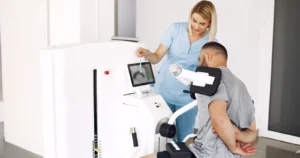Book Appointment Now

Spinal Cord Injuries: Etiology and Age-Related Variations
Spinal cord injuries (SCI) represent some of the most severe and life-altering medical conditions, profoundly impacting an individual’s mobility, sensory function, and autonomic processes. The etiology of SCI exhibits significant variability across different age demographics, influenced by factors such as lifestyle, developmental stage, and underlying health conditions. This article provides a comprehensive analysis of SCI causes and their distribution across various age groups, emphasizing the unique contributing factors at different life stages.
Defining Spinal Cord Injury
The spinal cord, a critical component of the central nervous system, facilitates bidirectional communication between the brain and peripheral structures. Damage to this vital structure can result in partial or complete disruption of these pathways, leading to varying degrees of paralysis, sensory deficits, and autonomic dysfunction. Spinal cord injuries are broadly categorized into two main types:
- Traumatic SCI: Results from acute physical trauma, such as impacts or accidents.
- Non-Traumatic SCI: Arises from medical conditions, including neoplasms, infections, or degenerative spinal disorders.
Prevalent Etiologies of Spinal Cord Injuries
While the physiological consequences of SCI remain consistent across age groups, the underlying causes demonstrate notable variation. Common etiologies include:
- Motor vehicle accidents: The primary cause of traumatic SCI, particularly among young and middle-aged adults.
- Falls: A predominant etiology in older adults, though it affects individuals across all age groups.
- Sports and recreational activities: A significant contributor in pediatric and young adult populations, especially those engaged in high-risk athletic pursuits.
- Violence: Including penetrating injuries and blunt trauma, a notable factor in certain demographic and geographic contexts.
- Degenerative spinal conditions: Non-traumatic causes such as spondylosis, osteoporosis, and spinal stenosis, often leading to SCI in older populations.
- Neoplasms and infections: Non-traumatic etiologies that can result in spinal cord compression and subsequent dysfunction.
Age-Specific Etiology of Spinal Cord Injuries
1. Pediatric and Adolescent Population (0-18 years)
In this demographic, traumatic etiologies predominate, largely due to the active and exploratory nature of childhood and adolescence. Key factors include:
- Sports-related injuries: High-impact activities such as gymnastics, contact sports, and diving pose significant risks. The developing spinal column in this age group exhibits increased vulnerability to traumatic insults.
- Bicycle accidents: Collisions with motor vehicles or falls from bicycles represent a notable cause of SCI in this cohort.
- Motor vehicle accidents: Particularly relevant for older adolescents, often associated with inexperienced driving, distracted operation, or alcohol consumption.
- Falls: Younger children face risks from falls involving playground equipment or elevated surfaces.
Non-traumatic SCIs are relatively uncommon in this age group, although congenital conditions such as spina bifida may result in early-onset spinal cord dysfunction.
2. Young Adult Population (18-35 years)
For young adults, motor vehicle accidents emerge as the predominant etiology of SCI. Risk-taking behaviors, including excessive speed, alcohol consumption, and non-compliance with safety restraints, contribute significantly to the high incidence in this demographic. Additional etiologies include:
- Motorcycle accidents: The elevated risk of ejection and impact during collisions increases the likelihood of SCI.
- Sports and recreational activities: Continued participation in contact sports and extreme activities contributes to SCI risk.
- Violence: In certain geographic and demographic contexts, young adults may experience SCI from violent encounters, including gunshot wounds or stab injuries.
- Occupational injuries: While less prevalent than other causes, physically demanding occupations may lead to SCI from falls or traumatic impacts.
Non-traumatic causes of SCI remain relatively infrequent in this age group, though spinal cord compromise may occur due to neoplasms, infections, or iatrogenic complications.
3. Middle-Aged Adult Population (35-55 years)
As individuals enter middle adulthood, the etiology of SCI begins to diversify. While motor vehicle accidents and falls remain significant contributors, there is an increase in work-related injuries and the emergence of degenerative spinal conditions. Key factors include:
- Vehicular accidents: Continue to represent a leading cause of traumatic SCI in this demographic.
- Falls: More likely to occur from significant heights or in hazardous occupational environments.
- Degenerative spinal conditions: The onset of conditions such as degenerative disc disease, osteoporosis, or spondyloarthropathies may increase susceptibility to SCI.
- Occupational accidents: Physically demanding professions expose workers to elevated risks of traumatic SCI.
- Neoplasms and infections: While less common, middle-aged adults may experience non-traumatic SCIs due to spinal tumors, infections, or post-surgical complications.
4. Older Adult Population (55+ years)
In the geriatric population, falls emerge as the predominant etiology of SCI. Age-related factors such as reduced balance, sarcopenia, and decreased bone density significantly increase both the likelihood of falls and the severity of resulting injuries. Specific considerations include:
- Falls: Even low-energy falls can result in SCI due to the increased fragility of the aging spine.
- Degenerative spinal conditions: Conditions such as osteoporosis, spinal stenosis, and spondyloarthropathies become more prevalent and may cause non-traumatic SCIs.
- Neoplasms: Spinal tumors, often metastatic in nature, may lead to cord compression and subsequent neurological deficits.
- Infections: Conditions such as osteomyelitis or epidural abscesses can result in inflammation and compromise of the spinal cord in older individuals.
Conclusion
The etiology of spinal cord injuries demonstrates significant variability across different age demographics. Pediatric and young adult populations are more susceptible to traumatic injuries from falls, sports-related activities, and vehicular accidents. In contrast, middle-aged and older adults face increased risks from degenerative conditions, falls, and age-related pathologies.
Understanding the age-specific etiology of SCI is crucial for developing targeted prevention strategies, optimizing treatment approaches, and improving long-term outcomes for affected individuals. By recognizing the unique risk factors associated with different life stages, healthcare providers, policymakers, and individuals can work collaboratively to reduce the incidence of spinal cord injuries and enhance the quality of life for those affected by these devastating conditions.



